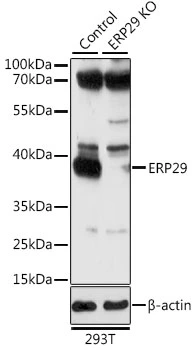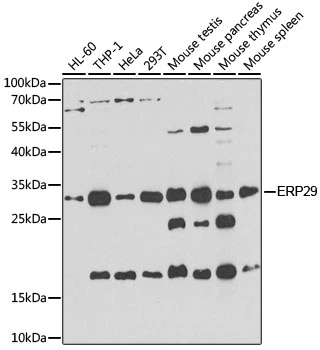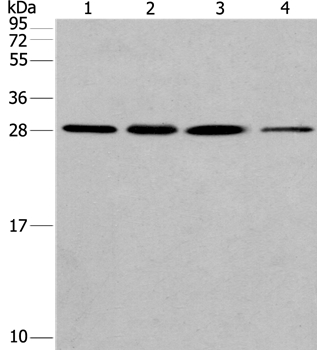
WB analysis of normal (control) and knockout (KO) 293T cell lysate using GTX55609 ERP29 antibody. Dilution : 1:1000 Loading : 25microg per lane
ERP29 antibody
GTX55609
ApplicationsWestern Blot
Product group Antibodies
TargetERP29
Overview
- SupplierGeneTex
- Product NameERP29 antibody
- Delivery Days Customer9
- Application Supplier NoteWB: 1:500 - 1:2000. *Optimal dilutions/concentrations should be determined by the researcher.Not tested in other applications.
- ApplicationsWestern Blot
- CertificationResearch Use Only
- ClonalityPolyclonal
- ConjugateUnconjugated
- Gene ID10961
- Target nameERP29
- Target descriptionendoplasmic reticulum protein 29
- Target synonymsC12orf8, ERp28, ERp31, HEL-S-107, PDI-DB, PDIA9, endoplasmic reticulum resident protein 29, endoplasmic reticulum lumenal protein ERp28, endoplasmic reticulum resident protein 28, endoplasmic reticulum resident protein 31, epididymis secretory protein Li 107, protein disulfide isomerase family A, member 9
- HostRabbit
- IsotypeIgG
- Protein IDP30040
- Protein NameEndoplasmic reticulum resident protein 29
- Scientific DescriptionThis gene encodes a protein which localizes to the lumen of the endoplasmic reticulum (ER). It is a member of the protein disulfide isomerase (PDI) protein family but lacks an active thioredoxin motif, suggesting that this protein does not function as a disulfide isomerase. The canonical protein dimerizes and is thought to play a role in the processing of secretory proteins within the ER. Alternative splicing results in multiple transcript variants encoding different isoforms. [provided by RefSeq, Dec 2016]
- Storage Instruction-20°C or -80°C,2°C to 8°C
- UNSPSC12352203







